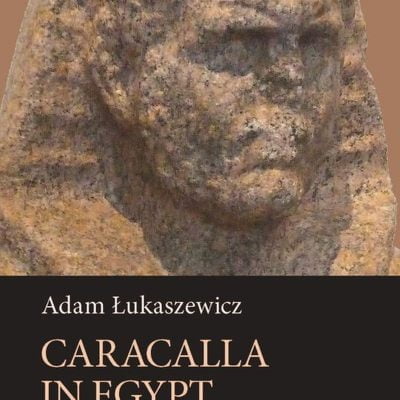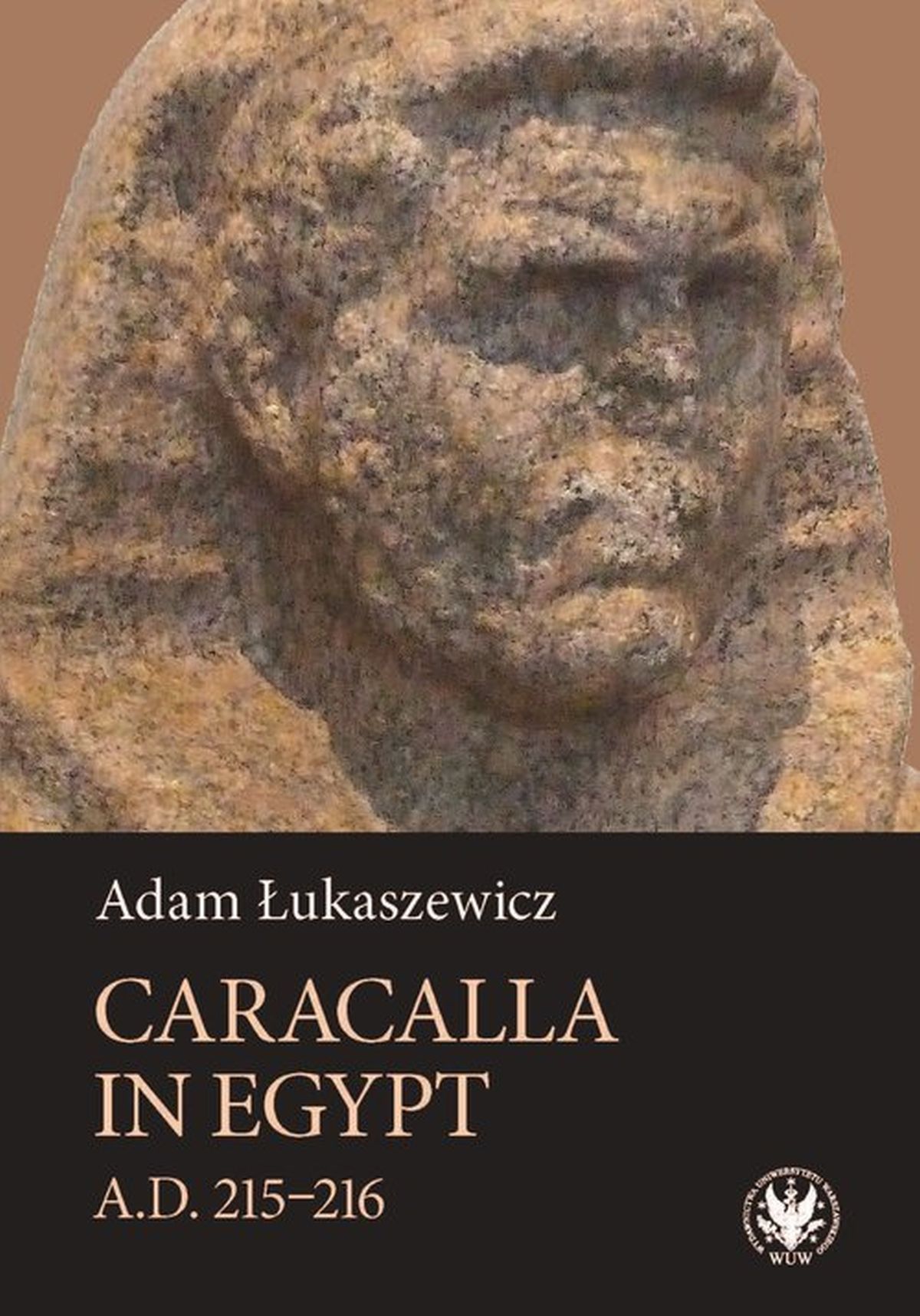Book “Caracalla in Egypt (A.D. 215-216)” by professor Adam Łukaszewicz is written in English and focuses on the events of 215-216 CE when the reigning Emperor Caracalla went on a journey to the eastern territories of the Roman Empire. During his stay in Alexandria, according to the records of ancient writers, the city’s inhabitants were to be murdered, at his order.
The author is an outstanding specialist in his field, and the book was written on the basis of his research in Alexandria in 1993. The book was originally published as a habilitation thesis under the Polish title “Aegyptiaca Antoniniana. Działalność Karakalli w Egipcie (215-216)”. The new edition, in English, is to make the analysis and conclusions of the Polish scientist available on the international market. In addition, the author added a tenth chapter (not present in the Polish version), in which he takes into account later studies (after 1993), which, in his opinion, emphasize his view of the events of 215-216.
As mentioned, the author divided the work into ten chapters, in which he discusses the events of 215-216 and his journey from present Turkey to Egypt, and finally his stay in Alexandria. The very expedition of Caracalla to the east was primarily of propaganda and sentimental nature, due to the adoration of the figure of Alexander the Great. It is also possible that the ruler’s entourage was making preparations for the planned party expedition in the coming years.
According to the analysis of the ancient sources left as well as contemporary works and research, the author concluded that Caracalla carried out the first executions before entering Alexandria when a delegation of inhabitants welcomed him and demanded certain obligations from him. Initially, the ruler had a positive attitude and finally sentenced the people to death. Caracalla’s subsequent stay in Alexandria was associated with numerous administrative and judicial tasks. Caracalla also expressed his dissatisfaction with the city authorities, which had previously sent him further envoys. There was also some unrest during Caracalla’s stay (for example, the expulsion of “true Egyptians” from the city or the linen weavers’ revolt).
In April 216, numerous festivals and ceremonies took place. For the time of the planned deification of Caracalla, young men from the city were summoned to appear in a given place – from among them he wanted to choose the most magnificent men and include them in his phalanx, created in honour of Alexander the Great, and which was probably supposed to take part in the planned expedition to the Party. At the appointed time, thousands of young men appeared at the appointed place. With time, Caracalla left the assembly point, and there were unrest and fights between the soldiers of Caracalla and the young Alexandrians. Caracalla, who came again, considered it a rebellion and sentenced the young men to death and the city to a pogrom (the so-called Magna caedes). Roman soldiers burst into the city and began raping and looting.
Interestingly, however, Caracalla’s popularity, despite these events, was still high in the provinces; this was probably due to the previously issued Caracalla edict recognizing all free inhabitants of the empire as Roman citizens.
Moving on to the book’s evaluation – the author cannot be denied the enormous knowledge, content and the number of sources and studies he used to write the work. The conclusions are clear, and the author presents a multitude of interpretations of events, both among ancient writers and contemporary researchers. As a disadvantage, I can only mention the fact that the translations of the quotes, most often given in Greek or Latin, are not included. Unfortunately for people like me – passionate about ancient history, but without knowing these languages - it is a big loss. Certainly, the quotes bring a lot of interesting content and would require a translation, at least in the footnote.
Moving on to the publication of the book – the item was published by the Publishing House of the University of Warsaw, in a hard and elegant cover. The book was printed on nice paper, and additionally, for the reader’s convenience, the footnotes at the bottom of the book. At the end of the work, there is a bibliography, abbreviations, index and selected colour photographs of the author from Egypt. The professional preparation of the book for printing is certainly to be appreciated.
In conclusion, the book is not suitable for every reader. In my opinion, the lack of translations in the footnote is a major disadvantage of the publication and sometimes makes it difficult to fully understand the context. It should be emphasized, however, that the author collected a huge amount of information about the events of the period 215-216 in the eastern provinces of the Roman state. People interested in this subject will surely obtain numerous data and valuable literature.
Adam Łukaszewicz
Caracalla in Egypt (A.D. 215–216)
Cesarz rzymski Marek Aureliusz Sewer Antoninus (188-217) żył tylko 29 lat, a cesarstwem rządził od 211 r. do 217 r. Był starszym synem Lucjusza Septymiusza Sewera i Julii Domny. Wychowywał się w środowisku zainteresowanym filozofią. Karakalla to przezwisko, które w starożytnych źródłach pojawia się w formie Karakallos (Caracallus) i oznacza płaszcz, którego cesarz często używał. Nowożytna nauka przyjęła ten przydomek, aby uniknąć pomyłek z innymi Markiem Aureliuszem znanym z historii rzymskiej. Po krótkim wspólnym panowaniu z bratem Publiuszem Septymiuszem Getą, Karakalla kazał go zamordować, prawdopodobnie pod koniec 211 r. W 212 r. cesarz nadał obywatelstwo rzymskie wszystkim mieszkańcom państwa. Jego marzeniem był podbój Wschodu i stworzenie światowego imperium. Karakalla był wielbicielem Aleksandra Wielkiego. Podobnie jak jego idol, nie stronił od pełnego niedogodności życia wojskowego i cieszył się popularnością wśród żołnierzy. Jednak gorący temperament i gwałtowne maniery Karakalli doprowadziły go do aktów okrutnej tyranii. Niniejsze opracowanie dotyczy tajemniczego epizodu wojny prowadzonej przez Karakallę na Wschodzie, co wpisywało się w naśladownictwo Aleksandra Wielkiego. W grudniu 215 r. cesarz przybył do Aleksandrii, egipskiej metropolii założonej przez Aleksandra. Jednak zamiast świętować pobyt w Egipcie, Karakalla skazał na śmierć zarządców prowincji i przedstawicieli lokalnego rzemiosła, a w kwietniu 216 r. dokonał masakry mieszkańców miasta.
Produkt jest tymczasowo niedostępny
Specjalnie dla Czytelników !!! niższe ceny po kliknięciu w poniższy link i wpisaniu hasła do rabatu: imperiumromanum



